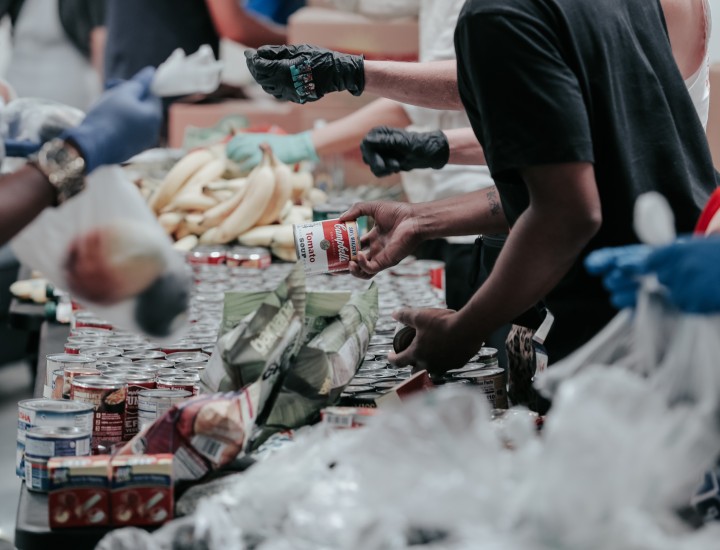Going back to normal isn't good enough. We need to Build Back Better.

“When one's life has been shattered into a million pieces, most set out to pick up the pieces & rebuild. Others look at those broken pieces & decide this is their opportunity to start anew, the bigger picture comes into view.”
â Sanjo Jendayi, author and spoken word artist
The COVID-19 pandemic has shaken our communities, our workplaces, and our families. As the virus has spread to reach thousands across our county, families are finding a new normal in social isolation. The economy remains closed with no clear end in sight, and our world has been transformed to online spaces, six feet distances, and an overwhelming feeling of unease and stress.
Families and communities are economically hurting. The pandemic is laying bare the stark inequities in our society, cleanly separating those with the means to self-isolate and to work remotely, from those who were already living on the edge and who must choose between further isolation and their income. It is now well documented how structural racism and discrimination have made Black and Brown people more likely to get sick and die from COVID-19, how the virus is raging among those who work in essential businesses with limited access to protective equipment and living wages, how school closures are disproportionately affecting those who lack adequate internet access to keep up with schoolwork.
Who catches the safety net when it falls?
Concurrently, our safety net sector itself is experiencing a uniquely taxing moment. Demand for safety net services has skyrocketed as millions file for unemployment. Many who have never used safety net services are suddenly in food pantry lines, in need of rent or mortgage relief, vulnerable to health insurance lapses, or in need of mental health support. Nonprofits are struggling to respond to canceled fundraising events, to put in place remote work capacity with outdated tech systems, to understand and respond to the myriad relief programs offered, to keep staff and clients safe while delivering more services that often rely on face-to-face interactions and personal connection.
Despite these challenges, we're hearing amazing stories of resilience from our community. Manna on Main Street, for example, has increased its meal delivery program threefold over the last month. Local YMCA's have redeployed their closed gyms and facilities to provide childcare services for first responders and other essential workers. Many nonprofits have found unique ways to provide services virtually, to engage new volunteers, and to continue fundraising efforts. Our local foundations have provided grant funds to COVID-19 relief, removed restrictions from grant funds, and otherwise sought to support nonprofit efforts in a coordinated and collaborative manner.
An uncertain future
However, these bright spots of hope do not mitigate the larger economic impact of the pandemic. While the Governor has released a plan for reopening the state, it is clear that the financial impact will be felt for years to come. The Governor's office is currently estimating a $5 billion deficit for next year's state budget. The first stimulus package of small business loans was quickly depleted; a second has been authorized by Congress and already discussions about a third have started. Millions of Americans are facing significant debt even after April's one-time stimulus checks and May rent is right around the corner. Two-thirds of small businesses across the country are projected to close permanently in the next 5 months, with a significant number of childcare centers projected to close- raising questions of how businesses and employees can return to work even when it is safe to do so. A quarter of nonprofits are reporting at least a 50% cut in revenue. Even houses of worship are facing permanent closure.
And, while comprehensive data is not yet available, we can be sure that the systemic inequities between rich and poor, White and Black and Brown, men and women, and corporations and workers will worsen as this crisis abates and recovery continues. Recovery will reinforce the inequities already in place.
What is becoming clearer than ever is that a return to “normal” isn't good enough or even possible. The impact of COVID-19 on our economy notwithstanding, returning to normal means a return to a world where zip code determines lifespan, where a Black baby in Montgomery County is over 2.5 times more likely to die than a White baby*, where 300 people are homeless in Montgomery County on any given night, where 10% of county residents are considered food insecure and 1 in 2 Pennsylvanians still struggle to afford healthcare.
Going back to normal means returning to a world where before the COVID-19 outbreak, 40% of the region's nonprofits operate with zero or negative operating margins, where policy discussions on safety net programs largely center on making it harder for people in need to qualify for services rather than improving outcomes or access, where services for people in crisis are siloed and uncoordinated. It means returning to a world where immigrants, many living here legally, struggle with access and eligibility to receive services, in their preferred language and delivered in a culturally competent manner, and where experiences of bias continue to pervade the sector.
Can we do better than "normal"?
As discussions to reopen our economy and our communities are underway, we all are anxious to return to the normal life that we knew before. Yet, at HealthSpark we wonder- is the collective experience of the pandemic the push we needed to create a better normal? As we pick up the pieces of our economy, our service sector, our homes and workplaces and schools, is there an opportunity to rethink the bigger picture? To envision a set of policies, practices, and structures that can make our social safety net just that- safe, secure, and capable of catching everyone when they fall?
It's with this new vision and challenge in mind that we are launching Build Back Better. Build Back Better is an approach to post-disaster recovery that aims to reduce organizational and system vulnerability to future disasters and to build community resiliency to address physical, social, environmental, and economic vulnerabilities and shocks. Through Build Back Better, we hope to:
- strengthen and nurture recovery-focused relationships,
- plan for and coordinate rehabilitation, and
- identify methods and procedures to inform and support reconstruction.
Build Back Better is a new supporting component of our larger 10-year effort to build a more just and financially resilient social safety net, called the Safety Net Resiliency Initiative. The Safety Net Resiliency Initiative is a community-driven effort, and our partners across the county have developed the Initiative's core strategies of convenings, leadership development, grantmaking, advocacy, communications, and research. Since launching these strategies in 2018, HealthSpark Foundation has expanded and deepened its partnerships, built momentum, and engaged in active learning about how to make Montgomery County's safety net system stronger.
Help us Build Back Better
Build Back Better will take place in three parts- a phase of learning and discovery, moving into community-driven design and planning, and ending with sharing our findings and moving them into action. You can learn more here, and stay up to date on the latest through our newsletter and future event to share our learnings with the community.
We invite you to join us for all or some of this campaign- whether you are a safety net provider, a funder, a community resident, own a small business or lead a faith group- you are part of building a better safety net system.
Together, we can build back better than ever before.
__________________________________________
*"Perinatal Periods of Risk Report February 2020: Understanding and Addressing Racial Inequities in Birth Outcomes in Montgomery County, PA". Report prepared by the Montgomery County Maternal and Early Childhood Consortium. More information available at https://www.montcopa.org/3256/Get-Involved-Disparities-In-Infant-Healt


